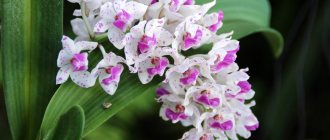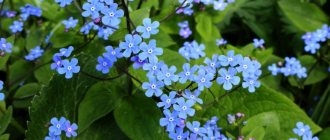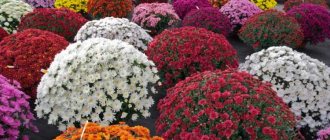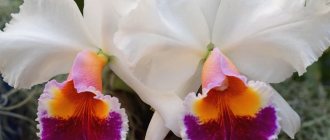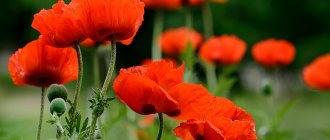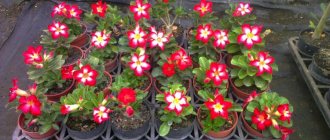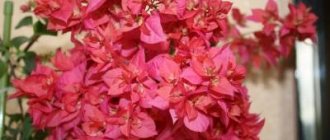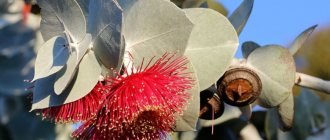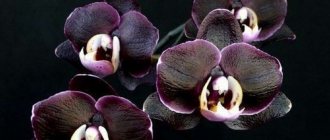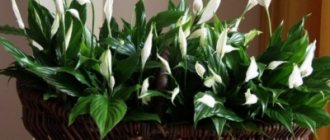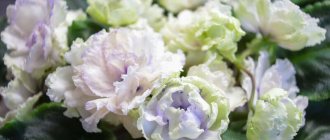Orchids are famous for their delicate buds shaped like moth wings. You can admire them not only on a trip to an exotic country. Many people have phalaenopsis growing in their indoor greenhouse - a home version of a tropical flower.
Anyone familiar with the potted orchid knows that it is odorless. When breeding, agronomists relied on large buds and the ability to bloom at any time of the year. But everything changed when European scientists developed phalaenopsis of bizarre shapes with a delicate aroma (see catalog with names and photos below).
Today, more than 50 manufacturers from all over the world are working on hybridization, and dozens of brands have been created. They all work in a similar way to the perfume industry, which is why the new type of orchids was called “Perfume Factory”.
Did you know that the fragrant phalaenopsis family has more than a hundred specimens. The most popular flavors are cinnamon, vanilla, chocolate, citrus, rose, hyacinth. The collection is replenished every year.
Possible difficulties
It is important for every amateur flower grower to know about certain obstacles that arise when growing a wonderful flower, as well as how to deal with them. Here are some problems that can mar the joy derived from the beauty of the yellow orchid:
- Wilting of leaves. The plant undergoes such a change due to too dry air. To prevent further development of the negative process, the flower along with the pot should be immersed in water for 2 hours.
- Stunted growth. The reason may be low temperature and untimely watering. Improper replanting has a bad effect on the growth of orchids. The shoot should be replanted only after new roots have formed.
- Dried roots. This phenomenon serves as a signal that the plant has accumulated excess salts. If the root system has turned brown, you should temporarily stop feeding.
- Root rot. Too much moisture promotes rot. In this case, you should delay watering and wait until the condensation disappears.
- Stains. If spots similar to burns appear on the leaves and flowers, then this is a consequence of sunlight. It is necessary to immediately provide the plant with the necessary protection from the sun.
- Lack of color. It is necessary to carefully examine the plant; it may have one of the above signs. Yellow orchid flowers may not appear due to irregular care. If the plant is healthy and there are no flowers on it, then you need to create better lighting. You can also use "Epin" to stimulate flowering. It is added to the water and sprayed on the plant.
- Pests. Orchids are susceptible to spider mites, aphids and scale insects. The prevention of this problem will be constant spraying of the flower. An acaricide based on dikkofol helps in the fight against ticks. If thrips or mealybugs are found on the plant, they should be washed off in the shower and then treated with chemicals.
Coconut chips
They are crushed coconut shells.
The product is porous, fibrous, breathable, with an optimal pH of 5.5-6, and contains a sufficient amount of nutrients. Due to its increased moisture capacity, it is used in combination with baking powder.
Used for growing young plants and terrestrial orchids. For adult epiphytic orchids, larger pieces of coconut are suitable.
Coconut chips: benefits and harms
Benefits of coconut substrate:
pH balanced environment. Fiber contains everything in the required quantities, so there is no need to adjust the acidity level.
Good breathability. Coconut provides an optimal ratio of air and water in the root system. The chips have a porous surface, which actively saturates the roots with oxygen.
Ability to accumulate moisture. The slices have a sponge-like structure that is capable of holding an amount of water five times the weight of the chips themselves. This quality makes them healthier than the famous mineral wool. Even after complete drying, the substrate is able to absorb water again.
Pregnancy of the material. You no longer have to waste time and money trying to get rid of pests. Orchids will hurt less and bloom longer. And all this thanks to coconut chips, which are pest-free.
They are able to accumulate minerals when they are in excess, and then use the “reserves” in dry and unfavorable conditions.
Reusable. A special substance - Lignite - allows coconut to remain unchanged for a long period of time. The shavings do not rot or deform, which makes them a unique substrate.
There are no downsides to coconut chips. The only problem is choosing the right one. You can run into unscrupulous sellers and buy low-quality chips.
Features of care
Review of types and varieties of the most beautiful yellow roses.
photo, description, tips for placement in the garden Phalaenopsis yellow, like a plant of another variety, requires full care. The general rules for maintaining this plant do not differ for different varieties. All plants quickly get used to home conditions, and then grow and develop fully. In order for a flower to delight you with long and regular flowering, you should follow these rules:
- Watering. Carry out according to a scheme suitable for other orchids. It is provided using the immersion method, when the pot is soaked in water for 15-20 minutes and simply watered on top. The main task of the grower is to ensure that the bark does not become damp, otherwise rotting may develop.
- Hot shower. As is the case with flowers of other shades, manipulation is carried out only during the period of active growth. After the buds appear on the peduncle, moisture ingress is unacceptable. Ignoring this rule will result in the appearance of pronounced brown spots on the flowers.
- Feeding. They must be carried out during the flowering period using a full dose of fertilizers. During the period of active growth, substances are used in ½ part of the dose.
- After the purchase. At this time, care is not provided according to a completely standard scheme. The plant often comes home literally “soaked” in fertilizer. Until all the chemicals are released, it is enough to simply water the crop and regularly wipe the leaves. Adding nutrient mixtures can have a bad effect on the rosette and subsequently lead to its death.
- Prevention of pest attacks and disease development. Insects, pathogenic fungi, viruses and bacteria are the real enemies of phalaenopsis. From their attacks, the culture can be seriously damaged, leading to serious losses.
We recommend watching the following video.
Phalaenopsis are unpretentious evergreens. Even novice gardeners can grow certain species and hybrids, since they do not require careful care and do not react painfully to non-compliance with certain conditions. With proper care, plants can bloom profusely and live in the house for up to 7-12 years. To make the plant pleasing to the eye, it should be placed in a well-lit place, providing protection from direct sunlight. Interestingly, in order to provoke flowering, you need to regulate the length of daylight hours - it is because of this that plant growers advise using (artificial lighting lamps). An equally important factor is the temperature. Tropical guests will not tolerate its drop to below +16 degrees.
Color spectrum
50 photos of different types and varieties of hyssop?, its beneficial properties and contraindications
In nature, there are a huge number of colors of phalaenopsis, both created by nature (for example: pink, purple, yellow, green, white), and colored by human hands using chemistry (black, blue, indigo, orange). Today we will talk about yellow phalaenopsis.
Yellow phalaenopsis - created by nature. His homeland is considered to be:
- South and Central America.
- Indonesia.
- Southwest Asia.
- India.
- Northern Australia.
But breeders do not stand still. They are constantly developing new varieties of this wonderful plant.
Breeders are developing a new color of yellow phalaenopsis, and are also trying to make the plant feel as comfortable as possible in its home environment.
Varieties and photos
50 photos of different types and varieties of cranberries, their beneficial properties and contraindications
There are up to 100 varieties of yellow phalaenopsis. The length of the peduncle can be from several cm to a meter in length. Now you will get acquainted with the most famous of them, and look at the photos:
This type is the most popular among gardeners. The leaves are folded and long. The flowers are yellow-orange.
The buds are pale yellow in color).
Dendrobium Lindley
A miniature herbaceous plant that reaches only 20 cm in length. It is popular among lovers of low miniature plants. One peduncle is strewn with 15,030 small yellow-orange buds.
Wild peach
The plant has dark pink buds with a lot of yellow spots. This variety of phalaenopsis smells very nice.
Harlequin
The plant has yellow buds, on which purple spots can already be seen. Each flower on one peduncle is unique: you cannot find a flower with the same size, shape and number of spots. At the same time, spots become brighter at low temperatures, and dull at high temperatures.
Catleya
The plant is very popular because it is unpretentious. The buds are double and have a bright yellow-pink color.
Flowers can be from a soft yellow hue to honey with a red area near the “tongue”.
Phalaenopsis is a delicate yellow color with purple splashes: small on the sides and larger closer to the center.
Cleopatra
Yellow phalaenopsis with medium-sized splashes throughout the entire surface of the flower. The “tongue” of this flower is purple.
The flowers of this plant can range from soft yellow to yellow-green.
Dendrobium Anna Green
This plant collects buds of different colors on one peduncle: from green to light yellow. The “lip” of this plant is purple.
Description of the plant
Cambria amazes with star-shaped or round flowers , up to 20 cm in size. Up to 15 beautiful flowers can be located on one arrow of a plant. The eyes are pleased with the variety of colors of buds and flowers: from white to brown. On the petals of one color are spots of a different shade in the form of specks or careless strokes.
The orchid's growth type is shoot (sympodial), it has several pseudobulbs. The narrow leaves of the plant reach 50 cm, are densely spaced, dark green in color, and have a noticeable central vein. Cambria produces up to two peduncles, which are removed after long flowering.
I would like to mention an unusual feature of the hybrid flower - different types of Cambria differ in color, shape and size of the flower and leaves. The only thing that unites the diversity of hybrid Cambria species is a shoot type of growth and several pseudobulbs with narrow leaves; sometimes all varieties are combined under one common name Cambria mix.
Studying the forums of flower growers, you can understand that when buying a flower you should pay attention to the number of pseudobulbs - there should be at least two of them so that the plant can delight you with flowers for several seasons.
The hybrid orchid family includes flowers such as: Beallara, Odontoglossum, Vuilstecarea, Odontoncidium, Colmanara, Burrageara and Wilsonara.
Cambria orchid - photo
Cambria orchid
How to plant an orchid?
It is necessary to follow all the rules for planting a plant so that it takes root normally and feels good. It depends on this whether the crop will bloom and how abundantly. It is worth taking a closer look at all the features of planting an orchid.
Choosing a substrate and pot
You need to approach this choice very responsibly. There are several requirements when choosing a pot:
- it must be transparent;
- a drainage system is required;
- You shouldn’t take a container for growing - it must be the optimal size so that the flower stands in it normally and does not fall;
- It is recommended to choose plastic pots.
The soil must contain the following substances:
- large bark;
- sphagnum moss;
- coconut fiber;
- coal.
Important. It is highly recommended to buy soil for your orchid.
This minimizes the risk of flower infection. He can hardly tolerate any illness, and there is a high probability of his death. When preparing the mixture yourself, you can take soil with pest eggs. Store-bought is completely safe, as it is enriched with minerals and disinfected.
Landing algorithm
Planting this variety of orchid is easy. It is only necessary to perform operations in a certain sequence:
- first you need to disinfect the pot;
- then place a drainage layer in it;
- then you need to pour the prepared mixture into the container;
- plant an orchid;
- Sprinkle the roots with a little soil on top.
Reference. It is forbidden to apply fertilizers immediately. It is necessary to give the flower the opportunity to acclimatize. To do this, it is placed in a shaded room for a couple of days. Only then can you place the pot where the orchid will grow constantly.
All about soils for orchids
Specialized stores sell substrates intended for flower cultivation. It should be noted that they are completely ready for use. They contain in the required proportions:
- bark;
- charcoal;
- sphagnum moss;
- coconut fiber.
Photo of the main components of the orchid substrate.
Common ready-made soils are Flower Happiness, Orchid, Effect soil mixture and many others.
You will find a detailed description of ready-made soils and reviews about them here.
Coconut
It is a natural, organic, brown component that is added to soil to increase its breathability. At the same time, it is an excellent moisture regulator that does not cake after prolonged use. It is often used when planting a plant on a block.
You can learn more about coconut soil here.
With your own hands
From the components you can make a good soil yourself, but then it should be disinfected in any way convenient for the grower. It can be calcined in the oven at a temperature of 200 degrees for 20 minutes. Or it is preferable to freeze it in the freezer of the refrigerator for 24 hours.
IMPORTANT! Disinfection is an important step and should not be skipped.
Bark
To grow a flower, the soil must contain bark. It is most often pine, but sometimes it is oak.
Moreover, before using both barks, they require mandatory heat treatment, where in the first case they get rid of the resin, and in the second case, they get rid of tannins.
The main property of the bark is uniform access of oxygen to the root system of the plant plus even distribution of water during watering.
Read more about bark for substrate here.
Seramis
This substrate, which appeared quite recently, immediately gained a positive reputation. The soil consists of bark and granules made from clay (70%), the rest (30%) are the necessary components containing Nitrogen, Potassium and Phosphorus.
The soil has:
- breathability;
- regulates the delivery of water to the root system of the plant;
- loose.
The peculiarity of planting in this substrate is that the roots do not need to be completely cleared of the old soil and Seramis can be used endlessly, just adding the required amount of granules when transplanting into a larger pot.
Seramis substrate.
Hydrogel
Experienced gardeners do not recommend planting orchid plants in hydrogel. Because in this kind of soil the root system will not live long, especially in the cold season: the root system comes into contact with the hydrogel and begins to rot.
IMPORTANT! Experienced gardeners consider the use of hydrogel when growing orchids to be a waste of money, since it not only will not improve the quality of the roots, but can lead to their death due to waterlogging.
You can read more about the content of orchids in hydrogel here.
Soil
Soil for orchids is sold in stores, it is completely ready for use.
It is usually suitable for all types of orchids and consists of:
- bark;
- charcoal;
- sphagnum moss;
- peat;
- pine needles.
Before use, it is soaked for a couple of hours in hot water so that the bark is well wet.
There are quite a lot of soils, as they are produced by many different manufacturing companies, and you should choose the mixture where the bark is cut into 1x1 cm fractions.
How often to change?
The soil for the plant is changed in the following cases:
- Planned spring replanting due to an increase in the overgrown root system - approximately once every 2 years;
- After purchasing a flower - one time after purchase;
- In case of illness - as needed.
IMPORTANT! When starting to transplant an exotic flower, it is necessary to carry it out by adhering to the basic rules.
What is the price?
The price range for substrates depends on the manufacturer and the weight of the bag itself. The soil can be hung in bags of 500 g. up to 7 kg. Therefore, the price can vary from 32 rubles. up to 150 rub. At the same time, products brought from abroad will cost more than domestic ones, but this does not mean that they are of better quality than those produced in Russia.
Varieties and their photos
All varieties of yellow orchid have the same structure:
- rhizomes;
- stems;
- sockets
They differ in shades of flowers, sizes and arrangement of petals in inflorescences.
Autumn Wind
Autumn Wind has light colored side petals called petals. And the petals of the upper and lateral sepals, called sepals, are dark in color. The flowers reach a size of 8 cm. Anthura Gold has pure yellow flowers with a darker core. They grow 5 cm in size.
Amadeus
The variety has bright yellow flowers, in which the sepals and petals are geometrically arranged evenly. They have the right shapes. The rosette has poorly developed petals and a brighter color. Flowers grow no larger than 7 cm.
Amalfi
The sepals and petals of the variety are pronounced yellow, and the lips of the petals may have a dark pink or purple tint.
Autumn Sun
The Autumn Sun orchid blooms with bright colorful flowers. Closer to the middle, there are purple and pink inclusions on the yellow petals and sepals, and there are more of them towards the center. Flowers grow 5 cm in size.
Orchid Narbonne: photos of representatives
The Mediterranean beauty of this orchid, with its warm coppery red and pink hues, will bring French sunshine into your home.
It is enough to look once at Narbonne to understand that this orchid has a history. This is noticeable in many components, including the muted matte, vintage coloring of its petals.
The orchid is endowed with the ability to change its color, so the play of halftones is interesting and multidimensional: pastel and soft peach shades suddenly begin to resemble young pink cider, or ripe watermelon pulp, and become lingonberry, carmine, orange.
Muted tones suit her perfectly. She is so charming in her naturalness - thin petals the color of a salmon rose, a red velvet lip with an amber throat, and all this is emphasized elegant, sweet and attractive - from speckled to deep burgundy.
Reproduction methods
There are two methods of propagation - seed and using sprouts.
The first method is ineffective, because it is very difficult to create a special environment for sowing at home. The seeds are small, like dust, and it is difficult to take root if the germination technique is disrupted. It is usually practiced in laboratory conditions.
The second option is more effective and justified.
Flowers over 3 years old produce babies (take those that grow in the upper part of the shoot, as the lower ones have poor survival rate). They are separated together with the stem so that the bottom and top are 2-3 cm long.
The plant does not reproduce easily
The cut areas are sprinkled with charcoal. Then they are immersed in one of the root growth stimulators for half an hour.
- The sprouts are planted in a nutrient substrate of steamed crushed pine bark, charcoal and sphagnum moss. As a planting container, you can use 100 ml plastic cups with holes in the bottom.
- The seedlings are irrigated with a spray bottle and placed in a warm and well-lit place.
For quick rooting, they can be covered with a transparent film. As soon as they begin to form new buds, the shelter is removed.
After 3-4 roots appear, they are transplanted into a plastic or ceramic pot slightly larger than the size of the roots.
Substrate processing
Elegant and sophisticated white orchid. description of popular varieties with photos
If for some reason it is not possible to purchase a ready-made substrate for orchids, you can prepare the substrate yourself. Personally collected components, for example, pine bark, must be carefully processed.
Selected ideal pieces of bark need to be cleaned of dirt and sent to a cold place to rest to get rid of insects.
Then heat treatment is carried out:
- A large piece of bark is broken into several smaller ones and placed on the bottom of unnecessary dishes (an old steel or aluminum pan, as well as a galvanized bucket, will do).
- The bark is pressed on top with cobblestones or other pressure so that the future soil does not float up.
- The container is filled with water, not reaching about 5 cm to the edge. Place on fire, bring to a boil, reduce heat and cook for at least an hour.
- Then the water is drained and the bark is thoroughly dried in the oven at 100 °C.
Watering
Frequent watering is not required for the orchid. It is enough to water the plant twice a week, and the water should be poured into a tray. You can also immerse the pot in a container of warm water for an hour or an hour and a half so that the substrate is saturated with moisture. In addition, you can use a watering can to wash away dust from the leaves.
The features of the container in which the plant is located allow you to observe the state of the root system, and, depending on this, decide whether the flower needs watering or not. When they dry out, the roots acquire a silvery color, and from excess moisture they become brownish-brown. In normal condition, the roots of the plant are bright green. It is worth remembering these features and watering the orchid when the soil becomes slightly dry.
Choosing a pot for an orchid
After purchasing or creating the optimal substrate, it is important to determine the correct container. You can use ceramic or plastic pots
The main thing is a large number of holes for drainage.
A plastic pot with transparent walls allows light to pass through well. Thanks to such materials, it is easy to control the condition of the roots and the level of soil moisture. From a practical point of view, this option is more preferable. Its disadvantage is its low aesthetic appeal.
Example of a pot
The clay version of the container for orchids is characterized by naturalness and good ventilation. Ceramics are heavier than plastic, so the plants in them are more resilient. The disadvantages of this version of the pot include the roughness of the walls and the fact that the soil in it dries out faster
When purchasing a container for an orchid, it is important to choose the right size in accordance with the size of the plant’s root system
Prevention
Basic care for this species includes a number of preventive measures that help maintain its health and decorativeness:
- washing the leaves and stems with soapy water once a month;
- avoiding drafts and maintaining a stable temperature regime;
- applying fertilizers strictly according to the schedule and at the above dosage;
- ensuring good lighting throughout the year;
- trimming flower stalks, yellowed and dried leaves;
- regular inspection for damage by diseases and parasites, as well as timely treatment with appropriate medications.
Varieties
Breeders have managed to develop various types and varieties of flowers designed for growth and development in the home environment. The color range is so diverse that sometimes the appearance of plants amazes the imagination. There are white and cream, and there are also burgundy and black orchids. The most popular of them is considered to be the yellow phalaenopsis. It can be delicate and pale, as well as bright and rich in contrast.
There are a large number of names for orchids with yellow flowers. Among them, the most famous are Meraldy Breckenbridge, Yellow Butterflies, Solid Gold and a number of other names. In these varieties, the lower petal of the flower is white with a purple tint. Part of the perianth sometimes has a yellow background with red spots along the edges or is marked with specks.
Orchids with yellow flowers differ in the size of the trunk, peduncle and buds themselves. Both large specimens and varieties of small plants have been bred. Phalaenopsis lives and blooms for up to 7 years. There are many orchids and their hybrids grown by domestic breeders. Let's look at the most colorful varieties of this amazing plant.
The leading place in sales in flower shops is occupied by an orchid called “Yellow Pearl”. Its flowers emit a very pleasant aroma, and the flowering period is quite long. This is a large-leaved plant, each leaf of which can reach a length of 18-20 centimeters. The orchid produces a long arrow, up to 60-70 cm, on which large flowers of bright yellow color with a pink core are concentrated.
Yellow orchids have different scents. There are types of very pleasant-smelling flowers, reminiscent of the smell of lilies of the valley. These include, for example, Sogo David. Its aroma becomes rich in the morning and evening hours. It is not found on sale very often.
Orchid Perfume Factory - what is it?
A few years ago there was only one variety of orchid, which was called “Perfume Factory”. The orchid had finely speckled leaves and a delicate lily of the valley scent.
However, soon, in response to the aspirations of many flower growers and collectors, European hybridization scientists developed a whole line of fragrant phalaenopsis under the general name Perfume, which became popular among the people under the Perfume Factory brand.
Its creators were employees of the first premium brand in floriculture - the Dutch cooperation Decorum, which has more than fifty manufacturers
Today it is difficult to buy such orchids, and they are not cheap.
Manifold
Almost all major orchid families contain species whose flowers are purple.
Here are some of them.
Purple Phalaenopsis orchid. This is the most common type, perfectly adapted for living at home. It survives well in various temperature ranges. The dormant period of this plant is not pronounced. Flowers look like a butterfly. Shades of violet and lilac, and there are also colors from mauve to dark purple. There is practically no smell. Phalaenopsis also develop an aerial root system, which allows them to obtain moisture from the air. The most popular representatives of this variety are: Phalaenopsis Schiller, Phalaenopsis Luddeman and Phalaenopsis pink.
Vanda Orchid. This orchid is called the bearded orchid because in nature it develops a huge root system that resembles a beard. At home, the flower also grows long aerial roots. This plant lives well on a block and does not need soil. In addition, it can be mounted in a special flower pot or in a glass vase. The stems of the presented orchid are cylindrical; many leaves grow on them. Flowers can be of different sizes and have a pleasant aroma. The most common types of purple color: Vanda Sander, Vanda Rothschild.
Dendrobium. Quite a compact orchid. Lilac Dendrobium orchids are both epiphytic and lithophytic flowers. The epiphytic form predominates. In nature, such plants attach themselves to trees, their roots or branches, without parasitizing them. The shoots of the purple orchid are erect, but over time they change to a creeping form. At the base, the leaves are not collected in rosettes, but grow along the entire stem, and can also be located in its upper part. The shape of the leaves is a stretched ellipse, the texture of the leaf is dense. On each peduncle, which emerges from the axils of the leaves, 4 flowers up to 8 centimeters in size are formed.
Cattleya. This is one of the most spectacular orchids. It requires attention and concentration in creating conditions for health and beauty. Flower color varies from dark purple to bright red. Cattleyas have developed a special organ for storing nutrients. He calls it a pseudobulb. The main lilac orchids: Cattleya Bowring, Cattleya Gubastaya, Cattleya ecland, Cattleya Eclipse.
The Bletilla orchid is native to Japan and China. Its leaves can be variegated, although usually green. The flowers are often pink-purple. The plant does not bloom every year, so care must be followed. The main representative is Bletilla hyacinth.
Caring for all types of purple orchids cannot be the same. Because they have only one thing in common - the color of the flowers, and everything else is different.
Phalaenopsis. An unpretentious variety of orchids that can withstand temperatures up to +28 °C. And the minimum indicators for its normal functioning are +17 °C. Direct sunlight is harmful to purple phalaenopsis, so they usually organize diffused lighting or shade the flower. Watering is carried out approximately once a week or 10 days. You can also check the soil by touch, and if it is almost dry, then it’s time to water.
Wanda. Purple orchids are thermophilic. +25 °C is a suitable temperature for them. The immunity of this variety is directly dependent on the temperature regime. For example, a decrease to +20 °C for a week can lead to diseases and severe flower stress. Humidity should be at least 50%. The daylight hours of the purple Vanda must be 12 hours. If there is not enough light, then additional lighting is provided.
Dendrobium. The maximum temperature for this variety is +25 °C. But the minimum differs from others and is listed at +10 °C
It is important to observe the daily temperature difference. It should leave 5-7 degrees
Direct sunlight is contraindicated for this variety, and daylight hours should last at least 12 hours. A humidity of 60% is considered optimal. In the warm season, you can spray from a spray bottle. After this, you need to carefully wipe the water from the axils of the leaves to avoid rotting.
Cattleya. Like other orchids, Cattleyas love diffused translucent light. This is a flower of moderate temperatures, so maximum values should not exceed +25 °C. The minimum temperature is +12 °C ..+15 °C. Watering is organized through a tray, and air humidity is created around 60%.
Pancratiums are graceful relatives of Hymenocallis
The name "Nile lily", which is often assigned to pancratium, is largely controversial. The thing is that this nickname is typical only for a plant previously known as Pancratium speciosum and transferred to a completely different genus of bulbous crops - Hymenocallis speciosa. This plant is so popular that the names Hymenocallis and Pancratium are even considered synonymous. But in the genus of genuine Pancratiums there are many plants that can surprise you with their beauty no less.
Pancratsiums or pankratia are members of the Amaryllidaceae family (Amaryllidaceae). These are herbaceous bulbous perennials with large, regular, elliptical bulbs, usually covered with light orangeish scales, giving them a resemblance to onions. The diameter of the pancratium bulb is up to 12 cm. Over the course of a year, it forms several daughter bulbs.
Quite narrow, long, leaves gathered in a basal “bundle” are not so attractive as to make this plant stand out from any indoor collection outside the flowering period, but they look fresh and bright
It is the flowering that attracts all the attention in pancratiums. Hollow, powerful and tall (up to 60 cm) peduncles are crowned with narcissus-shaped flowers with a graceful structure
Large tubular flowers are collected in umbrella inflorescences.
The crown tube expands in the pharynx, the perianth is funnel-shaped, with narrow, spaced, symmetrically located lobes. Long stamen filaments develop along the circumference of the corolla, there is only one pistil, but it is snow-white, thin, elegant, up to 15 cm long. One of the undoubted advantages of pancratium is its aroma. The smell of pancratium inflorescences is reminiscent of sweet vanilla, very pleasant, does not interfere, but captivates with its persistence.
After flowering, pancratiums form nice fruit boxes, but pollination in the plant is a cross process and rather “mysterious”. It is not always possible to achieve results when attempting artificial pollination, and in nature, pancratiums are pollinated by only one single species of butterfly.
The number of pancratium flowers in favorable conditions increases every year. The beauty of a plant, modest at first glance, is revealed the better the older it gets.
The flowering period of pancratiums is usually limited to autumn and early winter, although, like any other indoor bulbous plant, this plant can bloom at any time. By shifting the dormant period, you can control the time at which the pancratium blooms. Each flower lasts about 5 days, the total flowering period is usually 3 weeks.
Pancratium illyricum
Features of care
Almost all types of yellow phalaenopsis are not considered difficult to care for plants, so even a novice gardener can grow them.
Capacity
A transparent plastic or ceramic pot with smooth walls and drainage holes at the bottom is suitable for growing.
The first option is more suitable, because the roots of this flower take part in photosynthesis and will receive the required amount of light, and you will also be able to monitor the state of the root system and react in time if it begins to dry out or rot.
Temperature
When growing at home, the flower needs to create a stable temperature regime:
- in spring and summer - 23-25°C during the daytime, and 15-16°C at night;
- in autumn and winter it is reduced to 17°C during the day and 12-13°C at night
Air circulation
The orchid does not react well to drafts, so it is taken to another room for ventilation.
In summer, it should be placed on a glazed balcony or loggia, where there is protection from the scorching sun. The flower can also be placed in the garden under trees or tall shrubs; at lunchtime they will create additional shade.
Humidity
The plant loves high air humidity - within 75-80%. To ensure this condition, spraying is carried out regularly. Additionally, place a container of water in the room and place the pot on a tray with wet pebbles or expanded clay.
In the winter season, it is kept away from heating devices so that it does not dry out and die.
Lighting
The flower needs good lighting
The best place to keep it would be a western or southwestern window sill, where there is diffused, long-lasting lighting.
During lunch hours, if necessary, create shading to prevent burns on the foliage.
The optimal duration of a day is 10 hours. In winter, this condition is ensured by fluorescent lamps. They are installed at a distance of 50 cm from the plant.
Feeding
A balanced and regular diet helps maintain the immunity and decorative properties of the flower at a high level.
| Term | Type | Proportions | Submission rules | Action |
| In spring and summer during the phase of active growth of green mass | Mister color station wagon | 1 cap for 3 liters of water | After watering, every 14 days | Stimulates the growth of roots, leaves and flower stalks |
| At the stage of budding and during the period of active flowering | Mister-color orchid | 1 cap for 1 liter of water | After moisturizing, every 10 days | Increases quality, brightness and ensures long-lasting flowering |
Trimming scheme
This procedure begins when the plant has completely faded and the arrows begin to turn yellow. To cut them, use well-sharpened and sterile scissors to reduce the risk of injury to the stems to a minimum.
Along with the shoots, yellowed, disease-damaged and shriveled leaves are cut off, and faded buds are also picked off. For disinfection, cut areas are dusted with powdered charcoal.
Watering
This species loves moderate moisture at home: in summer it is watered every three days, in autumn and winter - twice a month.
Watering technique: lower the pot with roots into a basin of water for 15 minutes, then wait for the remaining moisture to drain and move it to its original location.
Additionally, you can have warm showers under water at 40°C for one minute. Before this, the substrate and flowers need to be covered.
Irrigation of the crown helps maintain decorativeness and protects against the invasion of harmful insects. Spraying frequency - once a month.
Substrate without mold
The appearance of mold in a pot is usually caused not by the quality of the substrate, but by errors in caring for phalaenopsis. Probable causes: excess moisture, insufficient air circulation, poor lighting, low temperature and impervious heavy soil.
Prevention measures
Watering phalaenopsis should be done only after the substrate has completely dried. The interval between moisturizing depends on the time of year and the location of the orchid.
In winter, the frequency of watering is significantly reduced.
At this time, it is especially important to avoid drafts. It is necessary to select a pot for phalaenopsis based on the size of the root system, increasing the volume of the container with each subsequent replanting
It is necessary to select a pot for phalaenopsis based on the size of the root system, increasing the volume of the container with each subsequent replanting.
Orchids need to be provided with good lighting and ventilation - fresh air circulation prevents the formation of mold. Do not confuse adequate ventilation with drafts.
Problem solving
When mold appears, it is necessary to reconsider the conditions under which the orchid is kept.
Procedure:
- Remove affected soil components.
- Add a new substrate with the addition of perlite, activated charcoal and charcoal.
- Spray the ground part of the orchid with Fundazol. The composition of the solution is 2 g of the drug per 2 liters of water.
If the roots are damaged, then it is necessary to replant the phalaenopsis in the spring after flowering. Until this time, watering is noticeably reduced.
During transplantation, the root system must be disinfected - treatment with a solution of potassium permanganate will do.
Before reusing the pot, the container must be treated with a fungicide.
Novice gardeners sometimes mistake limescale deposits for mold, which can form due to the use of hard water for irrigation.
The substrate for phalaenopsis orchids is significantly different from the usual soil for planting indoor flowers. And the tasks assigned to him are completely different. By and large, the components of the substrate should serve as a good support for the orchid, provide aeration of the roots and gradually release moisture accumulated after watering.
What substrate for phalaenopsis do you prefer? What proportions do you follow when mixing the components, or do you buy ready-made soil? Please tell readers about your experience growing indoor orchids.
How to water phalaenopsis
The orchid does not require too frequent or abundant watering. It is enough to water the flower several times a week.
Watering methods:
- Water is poured into the flower tray.
- The pot with the orchid is immersed in water at room temperature for about one hour until the substrate is properly saturated.
- Using a watering can, dust and dirt are removed from the leaves.
The peculiarity of orchids is that their root system is visible. By the roots you can determine whether the phalaenopsis needs watering or not. Dried roots have a silver color, and roots that have been watered too often become brownish-brown. If you water your flower correctly, its root system will have a rich green color.
Causes
Damage to the root system often occurs because it was simply flooded with water before. This is a common mistake of novice gardeners who think that excess moisture will only benefit a tropical flower. Wet and swampy substrate are two different things. Root rot causes the roots to turn brown and soft, and nutrients are no longer delivered to the plant through its nutritional system, which is almost certainly a death sentence for the orchid.
With such a system, the roots will remain moisturized, but excess moisture will be drained away. When the first signs of decay appear, the roots must be removed immediately, since the rate of spread is very high.
Too much water prevents oxygen from penetrating to the roots, hence the unfavorable processes. Leaf growth will begin to slow, new leaves will appear pleated and existing leaves will turn yellow.
Variety of varieties
https://img2.badfon.ru/original/2048×1365/3/64/orhideya-vetka-lepestki-makro-4809
There are no yellow orchids in nature. All currently existing varieties of this shade are the result of the work of breeders. Flowers are obtained by crossing the most suitable hybrids and varieties. Now similar orchids from the genus Phalaenopsis are presented in several versions. There are many varieties, but we will look at the most famous and popular:
- Lycasta is fragrant or aromatic. It looks like an epiphytic orchid. the plant has folded, slightly elongated leaves. The homeland of the plant is considered to be Guatemala, Honduras, and Mexico. In spring, the crop produces several flower stalks, which bloom almost simultaneously. They reveal fragrant yellow-orange buds.
- Phalaenopsis Golden Solid. Often found in flower shops, rarely has 1 peduncle, in most cases there are 2 or more. The advantage of this variety is long flowering; with proper care, the buds will last for 2-3 months after complete dissolution. Plants can be presented in different sizes, and the price depends on this. Standards are considered the most common.
- Brother Sara Gold. The variety is classified as a midi size orchid. It reaches 30-40 cm in height. The most memorable thing is the coloring; the inflorescences have a pronounced golden color with a barely visible iridescence. Another advantage is the smell; many people think that the flowers smell like caramel. A peduncle is formed on the plant 2 times a year, the duration of the period is about 2 months. Brother Sara Gold is a long-liver; it fully retains its vegetation characteristics for 10-12 years.
- Gold Leopard. Valued by flower growers for their very large buds, they reach 10-15 cm in width. Stays on the plant for a long time after dissolution. The variety cannot be called exactly yellow, this shade is only in its middle, and all the petals are strewn with purple or crimson speckles.
- Golden Beauty. The plant has very large flowers, with a pronounced red lip. Most often, the peduncle is formed in the shape of an arc, because it reaches more than 80 cm in height. Keeps beautiful inflorescences in bloom for 2 months.
- Trezor. The most beautiful and yellowest phalaenopsis orchid. Its flowers are painted a rich yellow, almost lemon. neon shade.
- Jaguar. The plant has standard forms. An adult specimen includes 4-7 leaf blades and has two peduncles reaching 70 cm in height. It is recommended to replant the flower as rarely as possible, no more than once every 2 years. The shade of the buds cannot be called exactly yellow, but rather “olive” or “lime”.
- Golden Star. This orchid is distinguished by its miniature size. The height of an adult plant without a peduncle rarely exceeds 25 cm. The advantage of the variety is that it blooms readily; it easily forms buds. The main task of the gardener is to normalize watering in order to avoid excessive waterlogging of the root system.
Gorgeous varieties of yellow orchids are discussed in the following video.
Cambria orchid - replanting
The issue of replanting must be approached with great care - it is very important not to damage the fragile roots in the process and give the flower the opportunity to recover in a new place. Reasons for placing it in a new pot may be reproduction, roots spreading throughout the soil, or noticeable foulbrood. If experienced gardeners are in good health, they replant cambria approximately once every 2-3 years after flowering has completely faded.
Before transplanting, they try not to water the plant for a long time, especially if the reason for transferring it to a new pot lies in possible rotting of the roots. You need to buy a plastic pot, medium in size. Do not transfer the plant to a pot that is too large. They sell special transparent containers for orchids - they make it easier to monitor the process of root growth and the need for watering.
Step-by-step transplant process
- Buy special soil for orchids - you only need to replant them in a fresh mixture full of nutrients. If you want to pour fresh, independently collected bark into a pot, then you must boil it and leave it to soak overnight. Once dry, this bark will provide an excellent environment for root development.
- Remove the old plant. If you want to propagate, then you need to carefully separate the bulbs, monitoring the condition of the roots. If their damage cannot be avoided, then the roots of the plant will have to be sprinkled with activated carbon.
- After propagation, the plants are transplanted into new pots. You will have to wait a while until they take root and it becomes clear whether the transplant went well. Until this moment, it is worth organizing a support with a thin twig. Cambria will begin to bloom after the death of old bulbs and the formation of new ones.
- When replanting a plant from an old pot to a new one, you need to very carefully sort through the thin roots, trying to remove as much rot as possible.
- The soil is poured into the pot without compaction - the more voids there are, the better for the plant. Pseudobulbs should not be deeply buried.
- Do not rush to water the transplanted plant. You can immerse it in water for the first time, as we described, 7-10 days after transplantation.
Orchid flower meaning
If you look into the scientific literature, it turns out that this plant is a representative of the orchid family, belongs to the class of monocots and the type of asparagus. In Russian, the family that includes this incredibly luxurious flower, recognized throughout the world as an aristocrat among other plants, is called more than trivially - orchis. Actually, the translation of the name of the flower from ancient Greek cannot be called beautiful either - “orchis” means “testicle”, so it was named because of its rounded rhizomes. But in Latin, “orchid” sounds much more noble - “originating from God.”
Of course, both names have a right to exist, but what the orchid symbolizes in Latin - and this is no more, no less, but “the highest perfection” - does not at all fit with a simple “testicle”.
In different countries, the orchid flower has different meanings related to cultural characteristics:
Vietnam
In the country, the time of blooming of these luxurious flowers coincides with the celebration of the New Year according to the lunar calendar. This period occurs at the beginning of spring and the orchid is a symbol of warmth, love, and renewal for the Vietnamese. Its incredible aroma intoxicates, causes passion and boiling in the blood.
Latin American countries
In many states, the flower not only has a huge symbolic load, but it also acts as a national symbol. It was and continues to be used in rituals, for making amulets and amulets.
China
The Chinese associate the main meaning of the orchid with its ability to disperse dark forces and protect against them. Archaeologists have discovered images of a flower dating back to 500 BC. e. Around the same time, Confucius, in one of his treatises, compared “the words of beloved friends to the most delicate aroma of orchids.”
Greece
For the Greeks there was no more sacred plant than the orchid. It becomes clear that the orchid was not just a part of many cultures, but occupied a significant place in them.
Problems of growing orchids
Even if you only have one plant, you need to know exactly what to do. This will help avoid the death of your indoor flower.
Important! By providing competent care for your orchid, you help ensure that fewer problems arise during the growing process, and the flower itself will delight you with abundant blooms for a long time.
Remember that the main difficulties are associated with mistakes and violations of the rules for caring for orchids. Let's list the main problems of growing.
The orchid's leaves are turning yellow
The most common occurrence among these indoor plants. It is worth remembering that each flower has a certain period when its leaves begin to change color and dry out - this is completely normal. If the lower leaves turn yellow, then there is no need to worry, this is a renewal process. Once the leaf is completely dry, it can be carefully trimmed.
Yellow leaf of an orchid.
But if the young leaves turn yellow, this indicates that the plant is sick. As a rule, problems appear due to poor watering (waterlogging or drying out of the soil). In winter, the leaves may begin to turn yellow due to drafts; it is also not recommended to keep the plant on a cold windowsill. In summer, leaves can also be damaged if they are exposed to direct sunlight. As a result, yellow or brown spots remain on the plate.
Problems with orchid roots
If you do not care for your orchid, its root system may suffer. Darkening or lightening of the roots means they have not been watered correctly. You should not overwater an orchid in the mistaken belief that it is a tropical plant. When there are rainfalls in their natural habitat, the roots absorb as much water as they need, while the rest simply flows down the trees.
Diseased orchid roots.
If you water an indoor orchid abundantly, the roots will begin to rot. But the humidity of the orchid is extremely important, so every morning spray the plant with a spray bottle. The water should be a little warm.
Orchid does not bloom
Quite often an orchid does not want to bloom. Sometimes this happens when the orchid has bloomed, a dormant period has passed, and a new peduncle has not appeared. This phenomenon occurs when there is not enough light.
The orchid does not want to bloom.
In winter, many species have a dormant period, so you should not wait for orchids to bloom at home. If you have a phalaenopsis, then provide additional lighting, then it will continue to bloom.
Useful: Procedure “Absolute happiness for hair”
The peduncle should be cut only when the orchid has faded. If it does not dry out, but has a pale green or brown tint, then, most likely, new buds should appear. What can you do to make your beauty start to please you with her flowers? Bud formation occurs when the plant is exposed to stress. The temperature should be no higher than 12 degrees, and watering should be scanty. Just do this gradually, also do not forget that the orchid loves differences in night and day temperatures. By following this orchid care regimen for 5 weeks, you can wait until the first buds appear.
Informative! If the orchid has not bloomed after six months, do not worry, the young plant produces flower stalks only after 2 years.
Diseases and pests
Orchids are quite resistant to diseases and pests, but troubles can still happen. Most often rot. This occurs due to waterlogging. If you violate the watering and spraying regime, this can contribute to the rotting of the root system and bulbs.
Diseases and pests.
It will be very difficult to cure a flower:
- Carefully remove the plant.
- Cut out the affected area with a disinfected knife (grab some healthy tissue).
- Treat the cut with a bactericidal solution.
- The orchid pot and substrate should be replaced. If you want to use an old pot, boil it thoroughly.
We will tell you below how to water an orchid so that it does not rot.
Of the harmful insects, the plant can be disturbed by mealybugs and spider mites. You can get rid of them with soap - wipe the leaves twice a day for a week.
How to properly care for yellow orchids
Dendrobiums are light-loving, so they should be placed on western and eastern windows. When placing a flower on a south window, it will need shading in the form of a curtain.
The ambient temperature for the plant in winter should be about 24 degrees during the day and 15 degrees at night. For some types of Dendrobiums, 12 degrees Celsius will be enough.
Dendrobium, with yellowish flowers that look amazing in photos, requires an air humidity level of about 60%. In view of this, the best option would be to place the plant on a tray with wet pebbles. In summer and spring, the orchid requires abundant watering; the substrate must be moist all the time. In winter, watering is significantly reduced, the soil should be almost dry. As for fertilizers, they are applied during the period of growth and budding of Dendrobium.
Among the pests that Dendrobium suffers from, we should highlight spider mites - they appear in dry air, scale insects and pemphigus. To prevent the appearance of pests, it is recommended to spray orchids periodically. If the air in the room is too humid, fungus may appear on the plant, so you need to carefully monitor the humidity level.
Dendrobium is propagated by air layering or division. You can divide a flower only once every 4 years, but removing the apical shoots is permissible every year. The optimal time for orchid propagation is from April to June.
In addition to the above, it is worth noting that Dendrobiums love fresh air, but do not tolerate drafts well. Flowering in plants is quite long - up to 19 days. Cut flowers can last from 4 days to 3 weeks.
